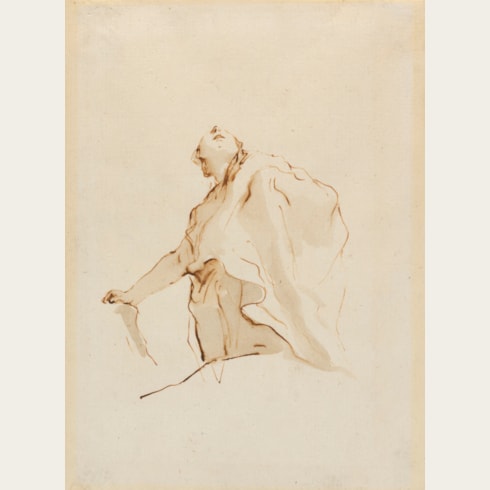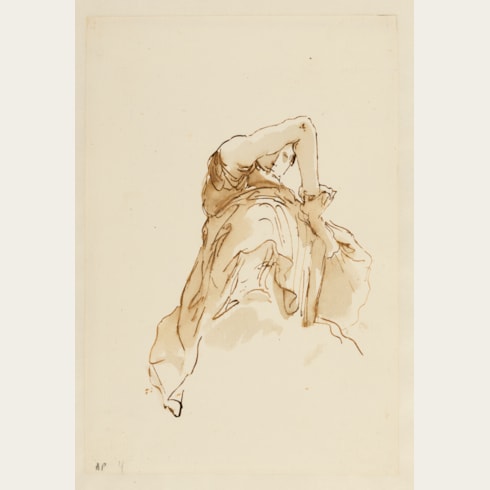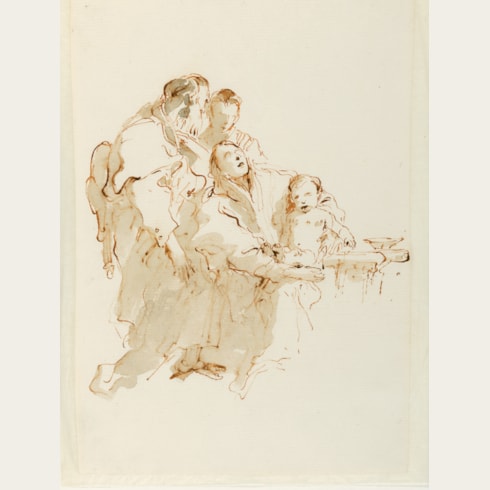Giovanni Battista TIEPOLO
(Venice 1696 - Madrid 1770)
Study of a Draped Figure
Inscribed J. B. Tiepolo on the verso, laid down.
242 x 163 mm. (9 1/2 x 6 3/8 in.)
ACQUIRED BY THE NATIONAL GALLERY OF ART, WASHINGTON, DC.
In the early part of his career, Giambattista Tiepolo drew in chalk on white paper, but from the early 1740s onwards adopted blue paper for his studies in black or red chalk. As such, the vast majority of extant drawings in red chalk by the artist are on blue paper. However, in his catalogue raisonné of the chalk drawings of the Tiepolos, published in 1980, George Knox noted that Giambattista occasionally used white paper for his chalk drawings in his later years, mainly during his time in Würzburg between 1751 and 1753, and again later in Madrid, where he worked from 1762 until his death in 1770.
A stylistically and compositionally analogous study of drapery by Giambattista, drawn in red and white chalk on blue paper, is found on the verso of a drawing in the Beurdeley Album now in the Hermitage in St. Petersburg, both sides of which are preliminary studies for a large altarpiece of The Adoration of the Magi, painted for the Benedictine abbey church at Münsterschwarzach in 1753 and today in the Alte Pinakothek in Munich. Another comparable drawing by Giambattista is a drapery study of a standing man, drawn in red and white chalk on white paper, which is part of the mass of Tiepolo drawings from the Bossi-Beyerlen collection in the Staatsgalerie in Stuttgart. A number of similar studies of drapery are also to be found in several pages in the large sketchbook known as the Quaderno Gatteri, today in the collection of the Museo Correr in Venice. Numbering eighty-seven pages of blue paper, the Gatteri sketchbook contains drawings in both black and red chalk, and seems to have been used by both Giambattista and Domenico Tiepolo between 1749 and 1752.
This drawing is thought to have been part of the large collection of drawings by Giambattista Tiepolo, many dating from his late Spanish period, assembled by the 18th century collector Armand-François-Louis de Mestral de Saint-Saphorin (1738-1805). Born in Switzerland but naturalized as a Danish citizen in 1776, he served as Danish ambassador to Poland, Spain, the Netherlands, Russia and Austria. He is known to have been in Madrid in 1774, and seems to have bought around a hundred drawings – both pen and ink drawings and chalk studies - directly from the Tiepolo studio in Madrid, or possibly in Venice. As such, his was one of the earliest and most significant collections of Tiepolo drawings outside Italy. De Mestral de Saint-Saphorin’s collection eventually passed by descent to the Swiss physician Édouard de Cérenville (1843-1915) and thence to his son, René de Cérenville (1875-1968), of Lausanne. At his death in 1968, René de Cérenville left part of his collection to the Musée Jenisch in Vevey, but many others were dispersed on the art market in Switzerland.
The leading painter in Venice for much of his career, Giambattista Tiepolo was also undoubtedly one of the finest Italian draughtsmen of the 18th century. That his drawings were greatly admired in his lifetime is confirmed by contemporary accounts; indeed, as early as 1732 the writer Vincenzo da Canal remarked that ‘engravers and copyists are eager to copy his works, to glean his inventions and extraordinary ideas; his drawings are already so highly esteemed that books of them are sent to the most distant countries’. From the late 1730’s until his departure for Spain in 1762, Tiepolo enjoyed his most productive period as a draughtsman, creating a large number of vibrant pen and wash studies that are among the archetypal drawings of the Venetian Settecento. As one recent scholar has commented, ‘From the start of his career [Tiepolo] had enjoyed drawing as an additional means of expression, with equally original results. He did not draw simply to make an immediate note of his ideas, nor to make an initial sketch for a painting or to study details; he drew to give the freest, most complete expression to his genius. His drawings can be considered as an autonomous artistic genre; they constitute an enormous part of his work, giving expression to a quite extraordinary excursion of the imagination; in this respect, Tiepolo’s graphic work can be compared only with that of Rembrandt.’
Tiepolo’s drawings include compositional studies for paintings and prints, drawings of heads, figure studies for large-scale decorations, landscapes and caricatures, as well as several series of drawings on such themes as the Holy Family. Many of these drawings were bound into albums by theme or subject, and retained by the artist in his studio as a stock of motifs and ideas for use in his own work, or that of his sons and assistants.
Provenance


























